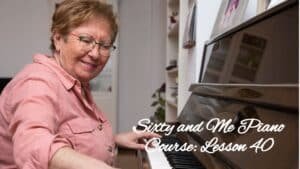
Welcome to Lesson 40, our last piano lesson for beginners!
[NOTE: If you are just joining us for the first time, you can find my previous Sixty and Me Free Piano Lessons on my Author pages. You can join our lessons any time and move at your own pace!]
40.1 Congratulations and I Hope You Had Fun!
This week we come to the end of our Sixty and Me Piano Lessons, as we play the final page of our Upper Hands Piano, BOOK 1. Congratulations on your determination! Learning how to play the piano is difficult, and if you persevered through our lessons, that is an enormous achievement.
As I wrote on p.96, you have learned so many piano skills, terms and concepts, and lots of popular songs and classical pieces throughout the course. In case you haven’t noticed, you have also strengthened your cognitive function, i.e., your brain power.
In numerous scientific studies such as this one, piano lessons have been shown to improve concentration, memory, mood, finger dexterity, audio-visual processing (which helps us to drive more safely), and what is called “executive function.” Executive function has to do with skills such as making decisions, carrying out plans, adapting to new situations, solving problems and managing emotions.
Studies also show that piano lessons enhance quality of life and decrease depression and anxiety in older adults. And importantly, piano lessons increase neuroplasticity, the brain’s ability to form new brain cells and neural pathways.
Besides all of the brain benefits, I hope you have found that along with its challenges, playing the piano is fun! Music is called the universal language not only because when we learn how to make music we can play with any musician anywhere in the world, but also because it is universally beloved. I think we all feel connected to the music of our youth, and by taking piano lessons, you are not only able to listen to your favorite songs, but also play them.
So Where Do You Go from Here?
First, I hope that you will continue your piano studies! Moving forward, here are some options you can explore:
Look for a Teacher: in Person or Online
I think this would be a great time to look for a piano teacher in your area, so that you can level up your practice. Look on bulletin boards at your public library, local grocery store or senior center. Or do a search for piano teachers online. You might search for, “Piano Teacher in Deltona, Florida.” Avoid the top few search results from Sponsored ads such as Pianoprof, PianoLessonsInAFlash, WebsterLessons, and see if you can find some legit music schools or private piano teachers in your area.
Teachers generally teach in their homes or a school, but some will come to your home for an extra fee. You can take lessons every week, or every other week, for 30 to 60 minutes (I think a 45-minute lesson is ideal). In-person lessons tend to be more effective than online lessons, but if online is all that is available to you, that’s fine too.
When interviewing piano teachers, get a sense of whether they have a personality you feel comfortable with, and find out if they enjoy teaching older adults. Check to see if they are ok with you using the Upper Hands Piano series. (Some teachers only want to use the same books they’ve been using for decades, or the books they use for kids, which are not great for adults.)
Of course I suggest that you move on to Upper Hands Piano, BOOK 2 next, so that you continue right from where you left off; in BOOK 2 you will learn more of the chords you need to know in order to play from Fake Books. If your prospective teacher has questions about the Upper Hands Piano method, they can contact me for information and sample pages.
Continue with My Assistance
If you are feeling resistant to having a piano teacher, or you can’t afford lessons at this time, let me know in the comment section below that you want me to continue offering demonstration videos for BOOK 2 on YouTube. Once I get at least 10 requests to post additional videos for BOOK 2 (there are already 9 videos posted here), I will start posting them page by page, as I did with BOOK 1.
Try a Gathering to Share Your Music
In addition, as I have mentioned before, try gathering friends together for a song circle, Piano and Poetry Party or some kind of creative sharing. Guests might play an instrument, read a poem, share their art or craftwork, bring a dish they prepared or some other creative endeavor.
You can make your gathering a wine and cheese party, or perhaps a potluck dinner or afternoon tea! When we share our music and support each other’s creative process, we feel less intimidated to play in front of others, and we feel encouraged to continue learning and creating.
Piano MeetUp
Some cities also have MeetUp groups where you can find other beginning musicians to play with.
Try My Blog
Subscribe to my free BLOG so that you can get free sheet music each month, plus exercises, worksheets and practice tips.
Practice Your Favorite 5
Maintain a repertoire of around 5 popular songs or classical pieces (as I discuss in my video 40.1 below and in Lesson 39) and review the pages that feel challenging to you, in BOOK 1.
Play on!
You are now ready to play from my Songs of the Seasons books. You can find them via my website. Check out my RESOURCES page to purchase a Fake Book or Easy(-ish) Classical Music Collection.
Watch my video for more on Where to Go from Here:
40.2 Country Garden, p.95 (top)
Notice that I played my left-hand bass F and G chords high. They are close to my right hand, and I had to move the G chord in the last measure out of the way when I played the right-hand treble D. You can choose to play the chords high, or you can move down low (to the left) to play the F and G chords if you prefer.
40.3 Goodnight Ladies, p.95 (bottom)
Goodnight Ladies has an F# in the Key Signature, so be sure to play the F#s when you play the D chords.
Passion Practice
- Exercise #4 – Play Exercise #4 in F#, D-flat, A-flat, E-flat, B-flat and F with your hands together. Remember that to play the Augmented chord at the end, you raise the top note (or 5th) of the major triad ½ step.
- p.95 – Country Garden – Practice the left-hand chords a few times before playing with hands together. Decide if you like the sound of the F and G chords going up or down, better, then play them that way consistently.
Goodnight Ladies – You have some 2-note chords in the right hand here. Practice hands separately then together. - Do the REVIEW on p.97-98. Use the page numbers at the end of each question to check your answers.
- Chord Calisthenics #1-5 – Review your chords – Major, Minor, Diminished and Augmented. See how many chords you can play without looking at the letters.
- Review the Minuet on p.89. Might you want to keep this popular Minuet in your repertoire?
If you would like to continue with BOOK 2 but don’t want to work with a piano teacher yet, leave a comment below letting me know that you want me to continue making page by page demonstration videos. Once 10 or more of you request them, I will start recording BOOK 2 videos.
Finally, let’s say thank you to Sixty and Me for hosting our free piano lessons! I have so enjoyed bringing these lessons to you, and Sixty and Me made that possible. I hope you will keep playing, and let’s stay in touch via Sixty and Me. Thank you so much and best of luck with your future music studies!
Let’s Have a Conversation!
How does it feel to complete BOOK 1, learning the piano? What were some of the high points and low points during your Sixty and Me piano lessons? Do you feel ready to move on to BOOK 2 or work with a teacher? Would you be interested in continuing with video lessons based on BOOK 2? Please let me know in the comments!





